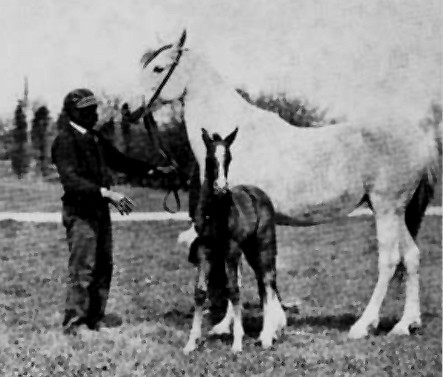Kuhaylan Hayfi: Early breeders
Early mentions of Kuhaylan Hafi by Western travelers to the desert link it to two Fad’aan clans (large families): al-Mahayd and al-Hubayqan.
Lady Anne Blunt mentions that the strain acquired a certain reputation when Turki Ibn Jad’aan al-Mahayd, the head of the Fad’aan tribe, was killed in a raid against the Ruwalah tribe, who captured his war mare, a Kuhaylah Hayfiyah. Turki was slain by Khalaf al-Adhn al-Sha’laan after he fell on the ground, his mare having stumbled on a jerboa – a desert rodent – hole. The Fad’aan felt that the Ruwalah had violated the rules of desert warfare, and a long feud between the two tribes ensued. Bedouin accounts of the story say that the mare was not captured, but that she made it back to the Fad’aan camp, where Turki’s fellow tribesmen ragingly hamstrung her for letting their leader down (yikes!). I don’t know the exact date of this event, altghough I suspect it took place in the 1890s.
The clan of al-Mahayd, which is the ruling clan of the Fad’aan, is generally acknowledged as the “owner” of the marbat of Kuhaylan Hayfi. Most hujaj (authentication certificates delivered for desert bred Arabian horses) of Kuhaylan Hayfi horses I have seen trace the horse in the hujja back to the clan of al-Mahayd. One particular hujja mentions “awlad Mahayd”, the sons of Mahayd. Another mentions Khalil ibn Hakim al-Mahayd, who in the 1940s maintained a large estate near the Khabur river in North Eastern Syria.
Another related Fad’aan clan also bred Kuhaylan Hayfi very early on: the clan of al-Hubayqan, a part of the Shumaylat section. An unidentified member of this clan is mentioned as the breeder of the Kuhaylah Hayfiyah mare *Reshan, imported by Homer Davenport to the USA in 1906 and pictured below. A hujja dating from the mid 1980s has the seal of a certain Mu’zi Ibn Hubayqan as the mukhtar (a local leader) of a small desert Syrian village, home to a dwindling number of settled Fad’aan tribesmen. The hujja is that of a Kuhaylan al-Musinn stallion, sired by a Kuhaylan Hayfi.

Correction thirteen years later: it’s Mu’azzi, not Mu’zi, and the name of the Ibn Hbayqan man who bred *Reshan was likely Lubaydan al-Hubayqan.
Noted!